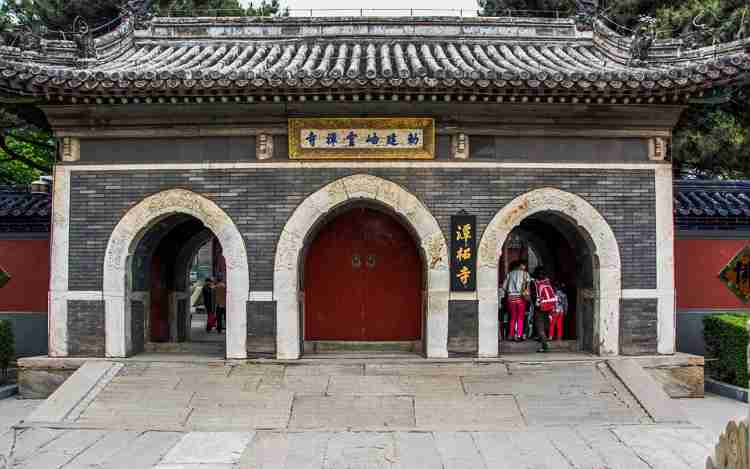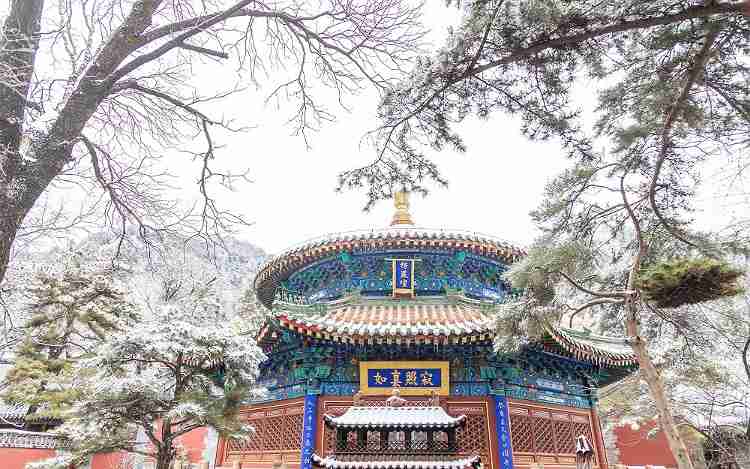Tanzhe Temple is located in Tanzhe Mountain, Mentougou District, about 40 kilometers (25 miles) from the city. Constructed during the Jin Dynasty (256-316), Tanzhe Temple enjoys a history stretching back 1,700 years and is the earliest Buddhist Temple in Beijing.
In former times its name was changed several times, but because there is the Dragon pool behind and wild mulberry (cudriana) trees on the mountain, local people always called it Pool and Mulberry Tree Temple or ‘Tanzhe Temple’ (Tan refers to the pool while Zhe refers to cudrania trees), and as time passed by this name was fixed upon.
Tanzhe Temple faces south and covers an area of 25,000 square meters (2.5 hectares). The existing buildings were mainly built in the Ming (1368-1644) and Qing Dynasties (1644-1911). The layout of it is arranged in an orderly fashion. Halls are mainly located along the central axis. Courtyards are situated in the east and various altars sit in the west.
Along the central axis

Big Bronze Pot
In front of Maitreya Hall sits a big bronze pot about 1.85 meters (2 yards) in diameter and 1.1 meters (3.7 feet) in depth, which was used as a cooking dish by the monks. There used to be three pots in total and this remaining one is the smallest. We can only imagine how many monks were in it at that time.
Mahavira Hall
Mahavira Hall houses the statue of Mahavira and his students. This double-tiered roof hall is covered with yellow glazed tiles and has glazed green adornments on both sides of the roof. The adornments are 2.9 meters (9.5 feet) high and engraved with dragons and clouds; they are said to be relics from the Yuan Dynasty (1271-1368).
Emperor Tree and Empress Tree
Behind Mahavira Hall there is a courtyard where two famous ancient ginkgo trees grow. The tree in the east is more than 1,000 years old, with a height of over 30 meters (98 feet) and a diameter of 4 meters (4.4 yards). Emperor Qianlong of the Qing Dynasty named it ‘the Emperor Tree’ during his visit. It is said that during the Qing Dynasty when a new emperor came to the throne a branch would grow up from the root, which made the tree more mysterious. The Empress tree in the west is a little smaller. People wish that the two trees were a couple; however, in reality they are all male.
Vairochana Pavilion
The double-floored Vairochana Pavilion, located at the end of the central axis is the highest building in the scenic spot. The carved brick art works on the roof lend an air of enchantment to the pavilion. A picture of eight dragons scrambling for a pearl is engraved on the front of the ridge while there are six phoenixes flying around peony flowers carved on the back. There are also two adornments on both sides of the ridge where more remarkable pictures are also sculpted.
On the face of the adornments a dragon chasing a pearl is depicted, while the picture on the back is a portrait of a dragon and a phoenix (Chinese people believe that both the dragon and the phoenix bring prosperity.). What makes this traditional picture special is the relative position of the dragon and the phoenix. In olden times the male was considered superior while the female was regarded as inferior in China.
So the dragon representing the male should be drawn above the phoenix that represents the female. But in this temple, the relative position of the dragon and the phoenix is inverted. There is a legend that explains the reason. The last reconstruction of Vairochana Pavilion was in the Qing Dynasty when Empress Cixi was the real power behind the throne, and this inverted picture was dedicated to the empress to please her.
Eastern Section
Floating Cups Pavilion
Floating Cups Pavilion is situated in the temporary palace in the eastern section of Tanzhe Temple. This wooden framed pavilion is covered with green glazed tiles and floored with white marble. The ten-centimeter (4 inches) wide winding trough was cut into the floor, like a coiling dragon. Water flows into the trough from the dragon’s mouth in east of the pavilion and out to the west. People used to sit around the trough and float a wine cup in it. Whoever the wine cup stopped in front of would then drink the wine and recite a poem. This is a traditional Chinese game.
Western Section
Avalokitesvara Hall
Avalokitesvara Hall (Guanyin Hall) is located at the end of the west side in Tanzhe Temple. Avalokitesvara is worshiped in the hall and it is also the place where Princess Miaoyan of the Yuan Dynasty (1271-1368) prayed to Bodhisatva after she became a nun. Princess Miaoyan came here every morning and night and as time passed by her footprints were left on the brick floor. In 1592 the Empress of Xiao Ding in the Ming Dynasty brought the bricks worn away by the princess’s footprints to the palace, but later the bricks were given back to it and became a treasure of the temple.
Stone Fish
To the west of Avalokitesvara Hall is Dragon King Hall, in front of which a deep green stone fish is hung. This fish, which is 1.46 meters (1.6 yards) long, weighs 150 kilograms (331 pounds). This fish was cut from a huge stony meteorite that contains bronze, so that if you rap on it you will hear a metallic sound.
It houses a great number of historic relics and ancient trees along with many other tourist sights both inside and out making it an unforgettable experience.
How to get to Tanzhe Temple

1. Take Subway Line 1 to Pingguoyuan Station, and then transfer to Bus 931 at the bus station in the west side and get off at the last stop Tanzhe Si (Tanzhe Temple).
2. Take bus 336 and get off at Pingguoyuan Subway Station, transfer to bus 931 and get off at Tanzhe Temple.
| Admission Fee: | CNY 55; Free for children under 1.2 meters (3.9 feet). |
| Combo ticket: Tanzhe Temple + Jietai Temple = CNY 80 | |
| Opening Hours: | Apr.- Oct.: 8:00–17:00 Nov.- Mar.: 8:00–16:30 |
Also Read
- Jingshan Park: Information and Guide in 2025
- Beijing World Park: Beijing Travel guide in 2025
- Great Wall of China: History, Information and Guide in 2025
- Longqing Gorge in Beijing: Information and Guide in 2025
FOLLOW US ON: Facebook / Twitter / Instagram / YouTube / Mastodon / LinkedIn